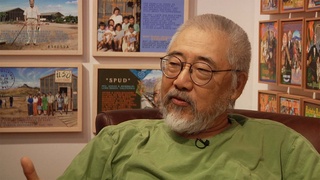Interviews
A Reporter’s Responsibility
Well, the fence was a very big issue. One of the main causes of resentment in the assembly centers was that they were all fenced in. And when they, these people first came to Heart Mountain, there was no fence surrounding the camp site. There was really no need for a fence. You could walk 20 miles through the sagebrush and not run into anything. And after the camp was pretty well settled, the army decided to put up a barbwire fence around the camp and put up watchtowers. ... As I recall, some of the camp leaders got -- organized a petition-signing campaign, as I recall. And they sent that on to the WRA.
And of course, this was important news. It had to be covered. And we did cover it with a -- it was the top story with a headline all the way across the top of page one. But at the same time, we had the responsibility of not stirring up the anger of the people so that there might be an incident. And that would've been very, very dangerous. So the paper had a responsibility to report the news without being provocative about it. And I think we managed to do that by playing the story right down the middle, the top story on page one. But we reported it objectively, and that satisfied the readership.
Date: July 13, 2001
Location: Washington, US
Interviewer: Alice Ito, Daryl Maeda
Contributed by: Denshō: The Japanese American Legacy Project.
Explore More Videos




The riot in Manzanar
(b. 1921) Nisei veteran who served in the occupation of Japan

Father’s Optimism
(b. 1934) Award-winning Disney animation artist who was incarcerated at Topaz during WWII

Tanforan Assembly Center
(b. 1934) Award-winning Disney animation artist who was incarcerated at Topaz during WWII

Father making shell brooches at Topaz
(b. 1934) Award-winning Disney animation artist who was incarcerated at Topaz during WWII

The lack of discussion about family’s incarceration in Amache
Sansei judge for the Superior Court of Los Angeles County in California


Foreign language education was severely restricted during the war
Professor of Law, University of Sao Paulo, Lawyer, Translator (b. 1948)

